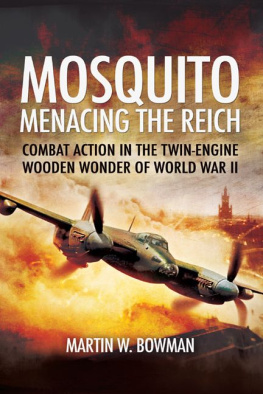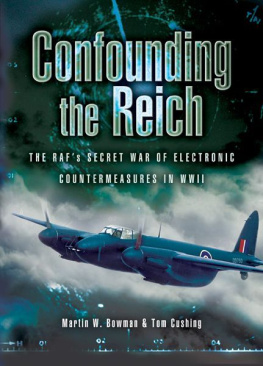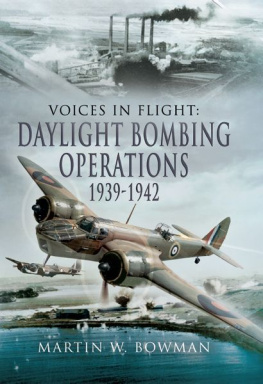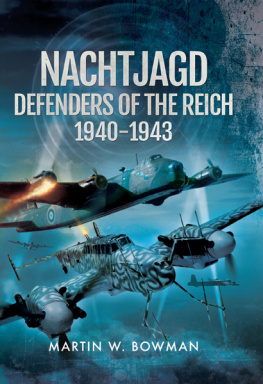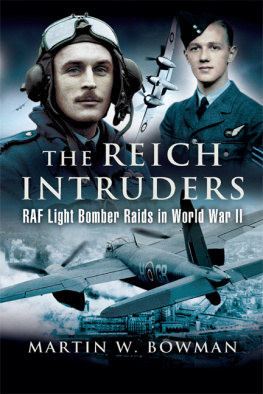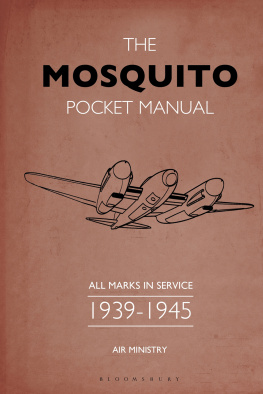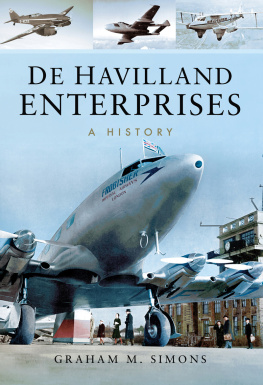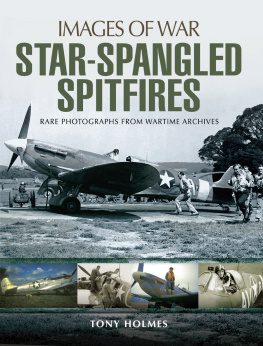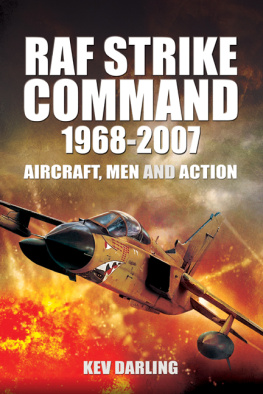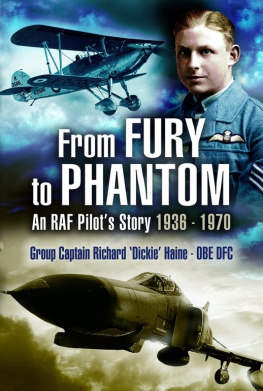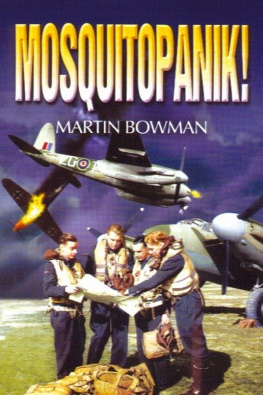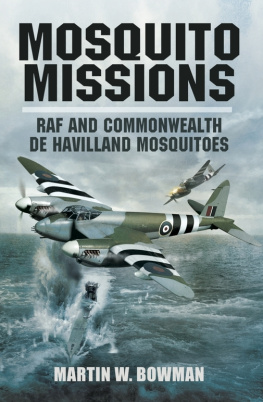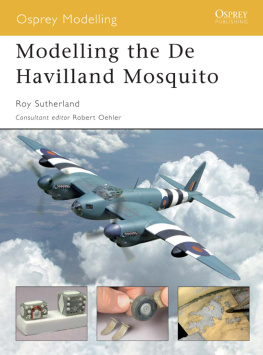
First published in Great Britain in 2008 by
Pen & Sword Aviation
An imprint of
Pen & Sword Books Ltd
47 Church Street
Barnsley
South Yorkshire
S70 2AS
Copyright Martin W. Bowman 2008
ISBN 978 1 84415 823 2
eISBN 978 1 84468 435 9
The right of Martin W. Bowman to be identified as the author of this work have been asserted by him in accordance with the Copyright, Designs and Patents Act 1988
A CIP catalogue record for this book is available from the British Library
All rights reserved. No part of this book may be reproduced or transmitted in any form or by any means, electronic or mechanical including photocopying, recording or by any information storage and retrieval system, without permission from the Publisher in writing.
Printed and bound in England by CPI UK
Pen & Sword Books Ltd incorporates the imprints of
Pen & Sword Aviation, Pen & Sword Maritime, Pen & Sword Military, Wharncliffe Local History, Pen & Sword Select, Pen & Sword Military Classics and Leo Cooper.
For a complete list of Pen & Sword titles please contact
PEN & SWORD BOOKS LIMITED 47
Church Street, Barnsley, South Yorkshire, S70 2AS, England
E-mail: enquiries@pen-and-sword.co.uk
Website: www.pen-and-sword.co.uk
Contents
CHAPTER ONE
Down Low
D ark clouds covered eastern England on 15 November 1941 when Blenheim aircrews of 105 Squadron braved the raw wind to gather near the hangars at the No.2 (Fighter Bomber) Group grass airfield at Swanton Morley, Norfolk to see a grey and green shape approach the aerodrome from the north-west. First it flew over at about 500ft, at a speed of 300 mph. Then it approached the Watch Office and hangar from the west and went into a vertical bank at a height of 2-3,000ft before turning a circle so tight and at such a speed that vapour trails streamed from his wing-tips. This was followed by a normal circuit and landing. It seemed that the rumours were true. For some time now the Squadron observers had attended conversion training on a new W/T and the gunners had started navigation courses, all amid speculation that they would be receiving a revolutionary type of aircraft built largely of wood to replace their outdated Blenheim IVs. Compared to the Blenheim IVs 105 Squadron was used to this performance was quite breathtaking. The tall frame of Company Chief Test Pilot Geoffrey de Havilland Jr. emerged from the tiny cockpit of the Wooden Wonder. He climbed down the ladder to be received like a conquering hero by Group Captain Battle OBE DFC, the station commander, and Wing Commander Peter H.A. Simmons DFC . Simmons air and ground crews were equally ecstatic. During September and October 105 Squadron had flown anti-shipping operations from Malta and losses were high. Returning to Swanton Morley, the surviving crews were due for a rest and in need of a morale boost. The arrival of the Mosquito provided it.
Sergeant (later Flight Lieutenant DFC ) Mike Carreck was an observer in one of the newest Blenheim crews fresh from No.17 OTU Upwood, 2 Groups finishing school. He and Pilot Officer Ronald Onley, first violinist in the London Philharmonic, were one of the half dozen or so crews posted to 105 Squadron at Swanton Morley: a hellspot only 15 miles from Norwich but which might have been in deepest Siberia, as Mike Carreck recalls:
Waiting there for us were just a few survivors from 105s bloodbath in Malta where fourteen days was the lifetime of a Blenheim squadron. We rightly regarded these battle-scarred veterans with the deepest respect but they made us welcome. Life at Swanton Morley began sedately enough.
Now and then we did a Blenheim cross-country, as I handed my pilot the course, compass heading and ETAs [Estimated Time of Arrival]. Sometimes we ventured as far away as Lincoln. We flew to the range and dropped teeny-weeny bombs and once, a special treat and with much trepidation, a 250-pounder. Dullish days but nights were duller still, as for recreation, romance and merriment one had to rely on nearby East Dereham where mothers locked away their daughters after tea and every door slammed tight shut on the dot of 18.00 hours. Nothing to do but go shivering to our beds in our freezing Nissen huts. Excitement was somewhat lacking; except for a nonsense of a rumour going the rounds that we were to be re-equipped with a fabulous new aircraft, the fastest in the world, a day bomber that could out-fly any fighter and leave it wondering where wed gone, that could fly 5 miles high into the stratosphere and had an incredible range of 1,200 miles. We shrugged our shoulders; wed believe it when we saw it, which we very soon did.
On 15 November it came suddenly out of nowhere, inches above the hangars with a crackling thunderclap of twin Merlins. As we watched, bewitched, it was flung about the sky in a beyond belief display for a bomber that could out perform any fighter. After a well-bred whisper of a touch down, a door opened and down the ladder came suede shoes, yellow socks and the rest of Geoffrey de Havilland. We pushed and shoved around this impossible dream of an aircraft. No other word for it, it was beautiful. An arrogant beauty with a job-to-do, get out of my way, slim, sleek fuselage, high cocked to-hell-with-you tail. It had awesome power on the leash in those huge engines and was eager on its undercarriage like a sprinter on the starting blocks who couldnt wait to leap up and away.
Called a Mosquito, they told us. It was Mosquito W4064 and it was to be shot down six months later on the squadrons first operation. During those six months only seven more Mosquitoes joined W4064 on the squadron so flights were few and far between; indeed we new boys had to wait weeks for our first. For us, it was back to Blenheims and Arctic nights, not counting a Station exercise when it was pretended that German paratroopers had landed and a batch of us were sent to guard the Sergeants Mess. We stretched out on the carpet; blissfully warm at last until somebody came in to wake us with the astounding news that the Japanese had bombed Pearl Harbor. We turned over to sleep our best night ever, the war was wonThree to a crew in a Blenheim, only two in a Mosquito so sadly some of our navs and WoPs were surplus to requirements. Sadder still they were posted to Blenheim squadrons flying in the Sea of Carnage, attacks on North Sea convoys whose escorting flak-ships didnt bother to aim, just fired splash into the sea, a curtain of exploding steel through which the doomed Blenheim crews flew with unmatchable courage.
Among the throng of seasoned pilots and their navigators at Swanton Morley on 15 November gathered to admire the Mosquitos beautiful shape was Flight Lieutenant D.A.G. George Parry, who like his CO, was a veteran of two tours on Blenheims. He was always known as George because, like the autopilot of the same name, he always came home! Parry had recently completed two tours and was resting at 13 OTU at Bicester when he just happened to pick up the telephone and receive a call from Pete Simmons who had been his A Flight commander in 110 Squadron at Wattisham. Simmons had rung to enquire when he was getting some more pilots, adding, by the way George, Im getting some fast aircraft. Do you want to come? Parry quickly turned down a posting to a squadron equipped with Bisleys going to North Africa and joined Simmons at Swanton Morley. The COs promise of fast aircraft had come true, although W4064 left almost as fast as it arrived. After lunch, Geoffrey de Havilland Jr. climbed back into the sleek Mosquito B.IV and was joined by Simmons, who took the right-hand seat for a joyride with a difference. De Havilland Jr. treated his passenger and the watching crews to an exhilarating display of aerobatics. When they landed, Simmons was reported to be ...looking a bit green around the gills, but it did not stop him talking about it in the Officers Mess during lunch!
Next page
